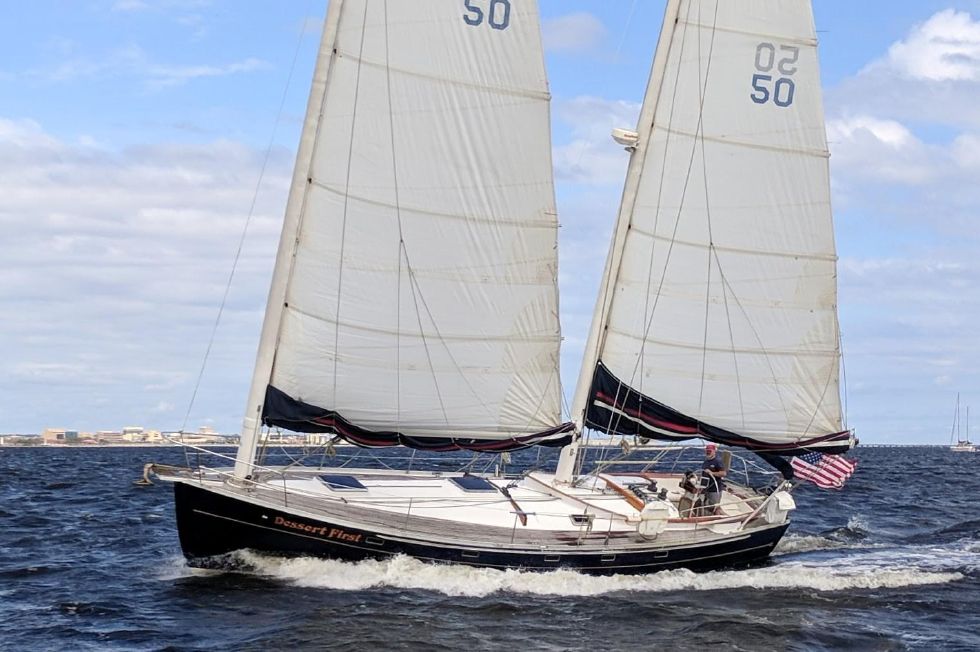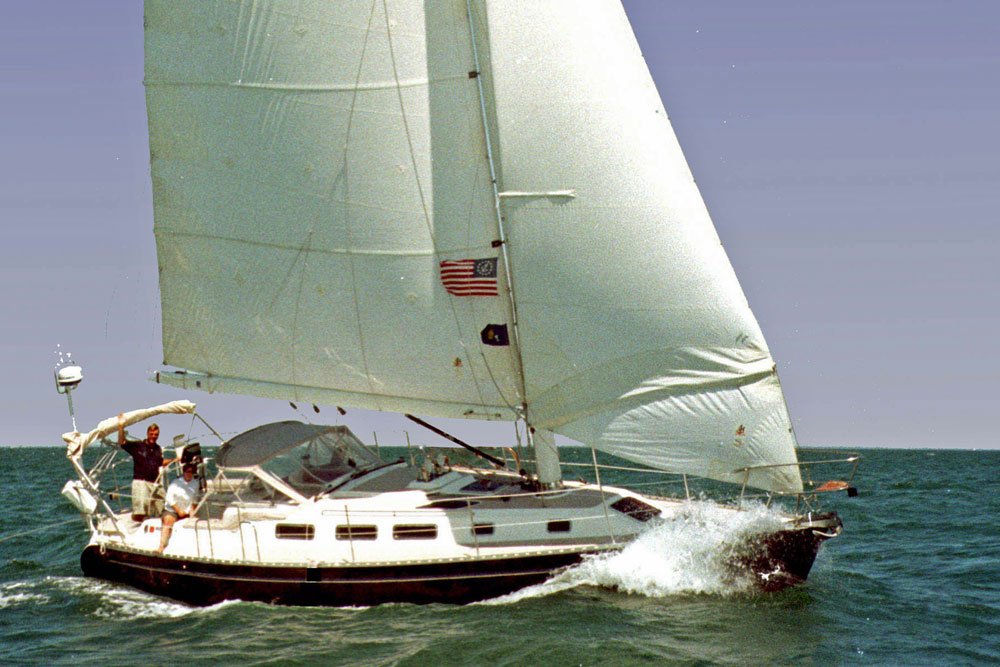- Home
- Types of Sailboats
- Cat Ketch Sailboats
Do The Unstayed Rigs Of Cat Ketch Sailboats Really Work?
Cat ketch sailboats are instantly recognizable by their tapered masts and total absence of standing rigging. There's nothing new about free-standing rigs though; they've been around for thousands of years - the Chinese Junk being the best known example.
But we have Gary Hoyt to thank for developing these sailboats for modern day cruising boats.
Hoyt, a former Finn Olympian and Sunfish World Champion, recognised that free-standing rigs would be just as successful on cruising sailboats as they were on his racing dinghies, and set out to prove it.
1977 saw the launch of Hoyt's Freedom 40 cat ketch, of which more than 90 have been produced to date.
 A Freedom 44 Cat Ketch
A Freedom 44 Cat KetchHoyt's early version had aluminium masts, but the development of carbon fibre spars combining strength, stiffness and light weight enabled these sailboat designs to be brought really up to date.
All unstayed masts are keel-stepped as they rely entirely on the cantilever thus provided by the deck for support. The mast is subjected to bending moment only, with none of the compressive forces that a stayed mast has to withstand.
The flexibility of the rig means that it's impossible to get sufficient forestay tension to support a conventional jib, so any such sail is likely to be a blade type set up on a fractionally rigged forestay. More often than not headsails are dispensed with altogether and a single-masted cat rig or ketch rig used - the Freedom 40 being a notable example.
Either conventional booms or wishbone rigs are used to support the clew of the sail. The wishbone rig greatly reduces the risk of head injury from an accidental gybe - a valuable safety feature indeed on cruising sailboats of any kind. Aerodynamically this rig is very clean - few yachtsmen will lament the loss of the rigging-induced whining when it starts to blow, but it does mean there's less to grab hold of when up on deck.
 A Freedom 40 with a blade-type jib
A Freedom 40 with a blade-type jibWeather Handling
One of the standout features of a cat‑ketch is the way its unstayed, flexible mast responds to the wind. Because the mast bends under strong gusts, the sail naturally flattens, reducing the power it generates. This built‑in de-powering effect makes handling gusty conditions less nerve‑wracking compared to more rigid, stayed rigs.
Certainly, this flexibility is a big advantage when faced with unpredictable weather. However, you might wonder: "Does that mean performance is compromised in light air or mixed sea states?"
In practice, while the flexible rig excels in calming a stiff sail during a sudden burst of wind, it requires some tweaks in conditions where you need every ounce of power to keep moving. Experienced sailors often note that you have to be a bit more hands‑on when the wind is light, adjusting reefing angles or even tweaking sail shapes to ensure you’re capturing every bit of available wind.
In short, while the system naturally self‑regulates in heavy gusts, there’s a balancing act in light air that calls for a bit of savvy sailing.
Upwind Efficiency
A common question that comes up is: how does a cat‑ketch fare when you're trying to beat the wind? Without the conventional tension provided by forestays, these rigs aren’t naturally optimized for upwind performance in the same way a Bermudan sloop might be.
This might sound like a drawback, but many seasoned sailors have their own tried‑and‑true adjustments. For example, altering the angle of the sail and using optimal reefing strategies can help maximize the drive when sailing close‑hauled.
It’s really about finding that sweet spot where you're balancing performance with the inherent simplicity of the design. You might lose that extra bit of efficiency compared to the classic Marconi rig, but you gain a cruising experience that's smoother and more forgiving.
In many cases, the convenience and safety benefits of an unstayed rig outweigh the slight loss in upwind efficiency—especially on long voyages where ease of handling becomes paramount.
The Cat Ketch Sailboat: A Few FAQs...
What is a cat ketch sailboat?
What is a cat ketch sailboat?
A cat ketch sailboat is a sailboat that has two masts, one at the very bow and one further aft, and no jib. The sails are usually triangular and attached to free-standing masts that can bend and de-power in strong winds.
How do you sail a cat ketch sailboat?
How do you sail a cat ketch sailboat?
Sailing a cat ketch sailboat is similar to sailing any other sailboat, but with some differences. Here are some basic tips:
- To tack, simply turn the boat through the wind and let the sails switch sides. You don't need to touch the sheets or the tiller during the manoeuvre;
- To jibe, turn the boat away from the wind and let the sails switch sides. Be careful not to jibe too fast or too hard, as this can damage the masts or cause excessive rolling;
- To reef, lower the halyard until the desired amount of sail is left, then secure it with a cleat or a knot. You can reef either or both sails depending on the wind strength and direction;
- To trim, adjust the sheets until the sails are set at an angle that gives you maximum speed and comfort. You can also use the wishbone booms to change the angle of attack of the sails.
What are some examples of cat ketch sailboats?
What are some examples of cat ketch sailboats?
Some examples of cat ketch sailboats are:
- The Freedom 40, designed by Gary Hoyt in 1977, was one of the first modern cat ketch sailboats. It has an aluminium mast forward and a carbon fibre mast aft, and can carry a small jib on a fractional forestay;
- The Herreshoff 31, designed by Halsey Herreshoff in 1979, is a classic cat ketch sailboat. It has wooden masts and wishbone booms, and can carry a spinnaker for downwind sailing;
- The Core Sound 15, designed by Graham Byrnes in 2015, is a small cat ketch sailboat. It has carbon fiber masts and conventional booms, and is suitable for beach sailing and day cruising.
What are the advantages and disadvantages of unstayed rigs on cat ketch sailboats?
What are the advantages and disadvantages of unstayed rigs on cat ketch sailboats?
Advantages:
- Absence of shrouds and stays means less weight aloft;
- Low centre of effort produces less heeling moment than a conventional rig;
- Flexible unstayed mast bends in strong gusts, flattening sail and de-powering it;
- Ease of tacking and jibing - just change course and the sail will flop over onto the other side of the boat without any drama;
- Running downwind is similarly stress free, with one sail out to port and the other to starboard. If the wind pipes up both sails can be eased forward, spilling the wind and steadying the boat.
Disadvantages:
It's often said that they're less efficient to windward than the Marconi Rig (the Bermudan Sloop), but off the wind they make up for it.
However, if you take a look at this this video of a heavily reefed 40 ft cat ketch sailboat overhauling a 48 foot cutter you'll have few doubts about their windward ability!
Cat ketches clearly have a lot going for them!
Seen alongside the complexity of a conventionally rigged sailboat, it's easy to imagine that the unstayed rigs of cat ketch sailboats represent the future for cruising sailboat designs
.........................
I wrote this article using GPT-4, OpenAI’s large-scale language-generation model, as a research assistant to gather information, summarize research findings, and provide suggestions for the content and structure of the article.
Dick McClary, creator and owner of sailboat-cruising.com
.........................
Recent Articles
-
Dix 43 Sailboat: Design, Specs & Performance Guide
Jul 05, 25 09:53 AM
Explore the Dudley Dix 43 sailboat's detailed specifications, design options, and sailing characteristics. A comprehensive guide for this robust cruiser. -
The Albin Vega Sailboat
Jul 05, 25 04:05 AM
Sailing characteristics, pics, specs and those all-important design ratios for the Albin Vega sailboat -
Grand Soleil Sailboats: Italian Flair, Performance & Luxury Cruising
Jul 04, 25 03:49 AM
Explore Grand Soleil sailboats – the ultimate blend of Italian design, robust construction, and exhilarating performance. Discover iconic models like the GS 37, 46 & more.












